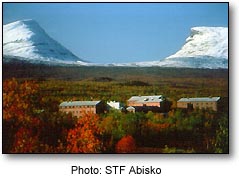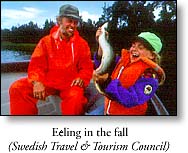|

|
Towards the end of August, the Swedish
sky begins to darken again, and the rythms of the world change. Migrating birds sail by in
vee formations. In the rivers of the south, the eels begin their own journey to the
Sargasso Sea. Eventually, the skies grow so dark that the eels can no longer see the
fishing nets, and they are easily caught. In Sweden, there can be only one way to mark
such a phenomenon: an eel party.

Similar in spirit to the crayfish parties, eel parties feature eel as the main delicacy,
and it is served in every form: smoked, grilled, stuffed, and more. Restaurants typically
throw contests to see who can lift the most live eels out of a barrel, and  crown the
winner the "eel king." Another fall culinary special is surströmming, or
fermented Baltic herring, which is popular in the north. Surströmming parties are also
very common at this time, and the tradition comes from the simple fact that at one time it
was cheaper to preserve fish by fermenting it than by storing it in salt. crown the
winner the "eel king." Another fall culinary special is surströmming, or
fermented Baltic herring, which is popular in the north. Surströmming parties are also
very common at this time, and the tradition comes from the simple fact that at one time it
was cheaper to preserve fish by fermenting it than by storing it in salt.

Fall is also a time to
visit the woods or the parks and experience the changing of the leaves. Mushroom picking
(for the experienced), as well as the picking of lingonberries and sweet, exotic
cloudberries, are popular. Sweden's last major fall tradition is the eating of goose in
the southernmost province of Skane on November 10th, St. Martin's Day. This is the
time when geese are at their fattest, and the meal in honor of the saint is accompanied by
a disputed sweet and sour "black soup," and an impressive meringue tower called
a spettkaka (a cake made of egg yolks and sugar).


 
Copyright (c) 1997 -
2008 interKnowledge Corp.
All rights reserved.
|
|


 crown the
winner the "eel king." Another fall culinary special is surströmming, or
fermented Baltic herring, which is popular in the north. Surströmming parties are also
very common at this time, and the tradition comes from the simple fact that at one time it
was cheaper to preserve fish by fermenting it than by storing it in salt.
crown the
winner the "eel king." Another fall culinary special is surströmming, or
fermented Baltic herring, which is popular in the north. Surströmming parties are also
very common at this time, and the tradition comes from the simple fact that at one time it
was cheaper to preserve fish by fermenting it than by storing it in salt. 